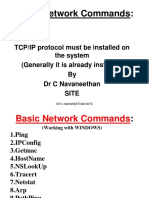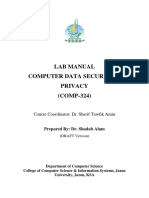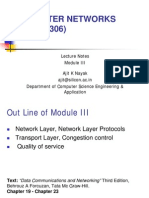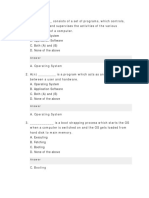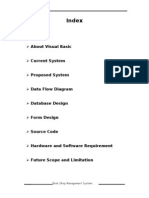0 ratings0% found this document useful (0 votes)
145 viewsTutorial Socket Programming
The document provides an overview of socket programming and the client-server model of network communication. It introduces key concepts such as sockets, the client-server paradigm, and socket functions for creating and managing connections. The main points covered are:
- Sockets provide an interface for application programs to communicate over networks using protocols like TCP/IP.
- In the client-server model, a client initiates contact with a passive server to make requests, and the server responds to service those requests.
- Socket functions support creating and managing connections between clients and servers, sending/receiving data, and closing connections. These include functions like socket(), bind(), listen(), accept(), connect(), send(), recv(), etc.
Uploaded by
Saad IqbalCopyright
© © All Rights Reserved
We take content rights seriously. If you suspect this is your content, claim it here.
Available Formats
Download as PDF, TXT or read online on Scribd
0 ratings0% found this document useful (0 votes)
145 viewsTutorial Socket Programming
The document provides an overview of socket programming and the client-server model of network communication. It introduces key concepts such as sockets, the client-server paradigm, and socket functions for creating and managing connections. The main points covered are:
- Sockets provide an interface for application programs to communicate over networks using protocols like TCP/IP.
- In the client-server model, a client initiates contact with a passive server to make requests, and the server responds to service those requests.
- Socket functions support creating and managing connections between clients and servers, sending/receiving data, and closing connections. These include functions like socket(), bind(), listen(), accept(), connect(), send(), recv(), etc.
Uploaded by
Saad IqbalCopyright
© © All Rights Reserved
We take content rights seriously. If you suspect this is your content, claim it here.
Available Formats
Download as PDF, TXT or read online on Scribd
You are on page 1/ 30
Tutorial on Socket Programming
Data types and structures for writing client-
server programs
Objectives
• Goal:
– How application programs use protocol software to
communicate across networks and internets
• Introduction to Client-Server paradigm of
interaction
Introduction
• Transport layer and layers below
– Basic communication
– reliability
• Application Layer Functionality
– Abstractions
– Names:
• define symbolic names to identify both physical and abstract
resources available on an internet
• Network
– transfers bits
– operates at application’s request
• Application determines
– what/when/where to send
– Meaning of bits
=> Application programs are the entities that
communicate with each other, not the computers or
users.
• Important point: For 2 application programs to
communicate with each other, one application
initiates communication and the other accepts.
Client/Server Model
How 2 application programs make contact
Server Client
•Starts first •Starts second
•Passively waits •Actively contacts
for contact from a a server with a
client at a request
prearranged
•Waits for
location
response from
•Responds to server
requests
• Client-server paradigm: form of communication used
by all network applications
Characteristics of a Client
• Arbitrary application program
• Becomes client temporarily
• Can also perform other computations
• Invoked directly by user
• Runs locally on user’s computer
• Actively initiates contact with a server
• Contacts one server at a time
Characteristics of a Server
• Special-purpose, privileged program
• Dedicated to providing one service
• Can handle multiple remote clients simultaneously
• Invoked automatically when system boots
• Executes forever
• Needs powerful computer and operating system
• Waits passively for client contact
• Accepts requests from arbitrary clients
Terminology
• Server
– An executing program that accepts contact over the
network
• server-class computer
– Hardware sufficient to execute a server
• Informally
– Term “server” often applied to computer
Direction of Data Flow
• Data can flow
– from client to server only
– from server to client only
– in both directions
• Application protocol determines flow
• Typical scenario
– Client sends request(s)
– Server sends responses(s)
Server CPU use
• Facts
– Server operates like other applications
• uses CPU to execute instructions
• Performs I/O operations
– Waiting for data to arrive over a network does not
require CPU time
• Consequence
– Server program uses only CPU when servicing a
request
The Socket Interface
• The Berkeley Sockets API
– Originally developed as part of BSD Unix (under gov’t grant)
• BSD = Berkeley Software Distribution
• API=Application Program Interface
– Now the most popular API for C/C++ programmers writing
applications over TCP/IP
• Also emulated in other languages: Perl, Tcl/Tk, etc.
• Also emulated on other operating systems: Windows, etc.
The Socket Interface
= file.dat
Internet
• The basic ideas:
– a socket is like a file:
• you can read/write to/from the network just like you would a file
– For connection-oriented communication (e.g. TCP)
• servers (passive open) do listen and accept operations
• clients (active open) do connect operations
• both sides can then do read and/or write (or send and recv)
• then each side must close
• There are more details, but those are the most important ideas
– Connectionless (e.g. UDP): uses sendto and recvfrom
Sockets And Socket Libraries
• In Unix, socket procedures (e.g. listen, connect, etc.)
are system calls
– part of the operating system
– implemented in the “top half” of the kernel
– when you call the function, control moves to the
operating system, and you are using “system” CPU time
Sockets And Socket Libraries
• On some other systems, socket procedures are not
part of the OS
– instead, they are implemented as a library, linked into the
application object code (e.g. a DLL under Windows)
– Typically, this DLL makes calls to similar procedures that
are part of the native operating system.
– This is what the Comer text calls a socket library
• A socket library simulates Berkeley sockets on OS’s where the
underlying OS networking calls are different from Berkeley
sockets
Some definitions
• Data types
int8_t signed 8-bit integer
int16_t signed 16-bit integer
int32_t signed 32-bit integer
uint8_t unsigned 8-bit integer
uint16_t unsigned 16-bit integer
uint32_t unsigned 32-bit integer
More Definitions
• Internet Address Structure
struct in_addr
{
in_addr_t s_addr;
};
Socket address structure
Socket Structure
Socket Types
Byte ordering
• Big Endian byte-order
The byte order for the TCP/IP protocol suite is big
endian.
Byte-Order Transformation
Address Transformation
Byte-Manipulation Functions
• In network programming, we often need to
initialize a field, copy the contents of one field to
another, or compare the contents of two fields.
– Cannot use string functions (strcpy, strcmp, …) which
assume null character termination.
Information about remote host
Procedures That Implement The Socket API
Creating and Deleting Sockets
• fd=socket(protofamily, type, protocol)
Creates a new socket. Returns a file descriptor (fd). Must
specify:
• the protocol family (e.g. TCP/IP)
• the type of service (e.g. STREAM or DGRAM)
• the protocol (e.g. TCP or UDP)
• close(fd)
Deletes socket.
For connected STREAM sockets, sends EOF to close
connection.
Procedures That Implement The Socket API
Putting Servers “on the Air”
• bind(fd)
Used by server to establish port to listen on.
When server has >1 IP addrs, can specify “ANY”, or a specific
one
• listen (fd, queuesize)
Used by connection-oriented servers only, to put server “on
the air”
Queuesize parameter: how many pending connections can be
waiting
• afd = accept (lfd, caddress, caddresslen)
Used by connection-oriented servers to accept one new
connection
• There must already be a listening socket (lfd)
• Returns afd, a new socket for the new connection, and
• The address of the caller (e.g. for security, log keeping. etc.)
Procedures That Implement The Socket API
How Clients Communicate with Servers
• connect (fd, saddress, saddreslen)
Used by connection-oriented clients to
connect to server
• There must already be a socket bound to a connection-oriented
service on the fd
• There must already be a listening socket on the server
• You pass in the address (IP address, and port number) of the
server.
Used by connectionless clients to specify a
“default send to address”
• Subsequent “writes” or “sends” don’t have to specify a destination
address
• BUT, there really ISN’T any connection established… this is a bad
choice of names!
Procedures That Implement The Socket API
How Clients Communicate with Servers
• send (fd, data, length, flags)
sendto (fd, data, length, flags, destaddress, addresslen)
sendmsg (fd, msgstruct, flags)
write (fd, data, length)
Used to send data.
• send requires a connection (or for UDP, default send address) be
already established
• sendto used when we need to specify the dest address (for UDP only)
• sendmsg is an alternative version of sendto that uses a struct to pass
parameters
• write is the “normal” write function; can be used with both files and
sockets
• recv (...) recvfrom (...) recvmsg (...) read
(...)
Used to receive data… parameters are similar, but in reverse
(destination => source, etc…)
Connectionless Client
Service (UDP) 1. Create transport
endpoint: socket()
Server
2. Assign transport
1. Create transport endpoint an
endpoint: socket() address (optional):
bind()
2. Assign transport
endpoint an 3. Determine address
address: bind() of server
3. Wait for a packet 4. Formulate message
to arrive: recvfrom() and send: sendto()
4. Formulate reply (if any) 5. Wait for packet
and send: sendto() to arrive: recvfrom()
5. Release transport 6. Release transport
endpoint: close() endpoint: close()
Server
1. Create transport 1. Create transport Client
endpoint for incoming endpoint: socket( )
CONNECTION-ORIENTED SERVICE
connection request: socket()
2. Assign transport
2. Assign transport
endpoint an
endpoint an
address (optional):
address: bind( )
bind( )
3. Announce willing
to accept connections: 3. Determine address
listen( ) of server
4. Block and Wait 4. Connect to server:
for incoming request: connect( )
accept( )
4. Formulate message
and send: send ( )
5. Wait for a packet
to arrive: recv ( ) 5. Wait for packet
to arrive: recv( )
6. Formulate reply (if any)
and send: send( )
6. Release transport
7. Release transport endpoint: close( )
endpoint: close( )
You might also like
- 14.8.1 Packet Tracer - TCP and UDP CommunicationsNo ratings yet14.8.1 Packet Tracer - TCP and UDP Communications6 pages
- Solutions Manual Power Electronics Circuits Devices Applications 4th Edition Muhammad H Rashid PDF67% (6)Solutions Manual Power Electronics Circuits Devices Applications 4th Edition Muhammad H Rashid PDF10 pages
- Configuration of a Simple Samba File Server, Quota and Schedule BackupFrom EverandConfiguration of a Simple Samba File Server, Quota and Schedule BackupNo ratings yet
- WAN TECHNOLOGY FRAME-RELAY: An Expert's Handbook of Navigating Frame Relay NetworksFrom EverandWAN TECHNOLOGY FRAME-RELAY: An Expert's Handbook of Navigating Frame Relay NetworksNo ratings yet
- Government College Women University Sialkot: Course Outline: CMP-301No ratings yetGovernment College Women University Sialkot: Course Outline: CMP-3017 pages
- Network Programming Lab Manual - Exp 1-5No ratings yetNetwork Programming Lab Manual - Exp 1-528 pages
- Socket Programming - Client and Server PDFNo ratings yetSocket Programming - Client and Server PDF3 pages
- Lab Manual Computer Data Security & Privacy (COMP-324) : Course Coordinator: Dr. Sherif Tawfik AminNo ratings yetLab Manual Computer Data Security & Privacy (COMP-324) : Course Coordinator: Dr. Sherif Tawfik Amin51 pages
- Unit - 5 - Chapter 3 - Creating, Updating, and Deleting Documents in MongoDBNo ratings yetUnit - 5 - Chapter 3 - Creating, Updating, and Deleting Documents in MongoDB60 pages
- OSI Model For Data Communication: Er. Avinash Bhagat 9463281930No ratings yetOSI Model For Data Communication: Er. Avinash Bhagat 946328193049 pages
- 4.1.2.4 Lab - Identifying Network Devices and Cabling75% (4)4.1.2.4 Lab - Identifying Network Devices and Cabling3 pages
- List of Programs For Class 12 Practical ExamNo ratings yetList of Programs For Class 12 Practical Exam6 pages
- Network Connections: Networking HardwareNo ratings yetNetwork Connections: Networking Hardware60 pages
- Lab-2 Networking Basics: What Is A Network?No ratings yetLab-2 Networking Basics: What Is A Network?6 pages
- Making Ethernet Cables - Simple and Easy: How To Make An Ethernet CableNo ratings yetMaking Ethernet Cables - Simple and Easy: How To Make An Ethernet Cable14 pages
- Introduction To Routing and Switching Network: Faculty of IT, Ho Chi Minh City University of Industry Dec 2013No ratings yetIntroduction To Routing and Switching Network: Faculty of IT, Ho Chi Minh City University of Industry Dec 201342 pages
- Understand The Working of Basic Networking CommandsNo ratings yetUnderstand The Working of Basic Networking Commands13 pages
- Experiment No. 4: Verify and Test Network Connectivity ONo ratings yetExperiment No. 4: Verify and Test Network Connectivity O9 pages
- Programming 2 (Structured Programming) : Worktext in ITC 106No ratings yetProgramming 2 (Structured Programming) : Worktext in ITC 10624 pages
- 11.3.4.6 Lab - Using The CLI To Gather Network Device Information20% (5)11.3.4.6 Lab - Using The CLI To Gather Network Device Information11 pages
- Packet Tracer - Creating A New TopologyNo ratings yetPacket Tracer - Creating A New Topology18 pages
- UCCN1004 - Lect2a - Intro To Network Devices - AddressingNo ratings yetUCCN1004 - Lect2a - Intro To Network Devices - Addressing28 pages
- Channels/random Access Channels, MultipleNo ratings yetChannels/random Access Channels, Multiple10 pages
- Belzona 1311 Original Specification SheetNo ratings yetBelzona 1311 Original Specification Sheet2 pages
- 005-Quotation Belzona 1311 DT 20-11-2014No ratings yet005-Quotation Belzona 1311 DT 20-11-20141 page
- Microprocessor Lab Viva Questions & Answers100% (2)Microprocessor Lab Viva Questions & Answers11 pages
- CSC 101 LECTURE NOTES - 09 - 05 - 2023 CompleteNo ratings yetCSC 101 LECTURE NOTES - 09 - 05 - 2023 Complete43 pages
- BCA 103 - Mathematical Foundation of Computer SC - BCA100% (1)BCA 103 - Mathematical Foundation of Computer SC - BCA274 pages














